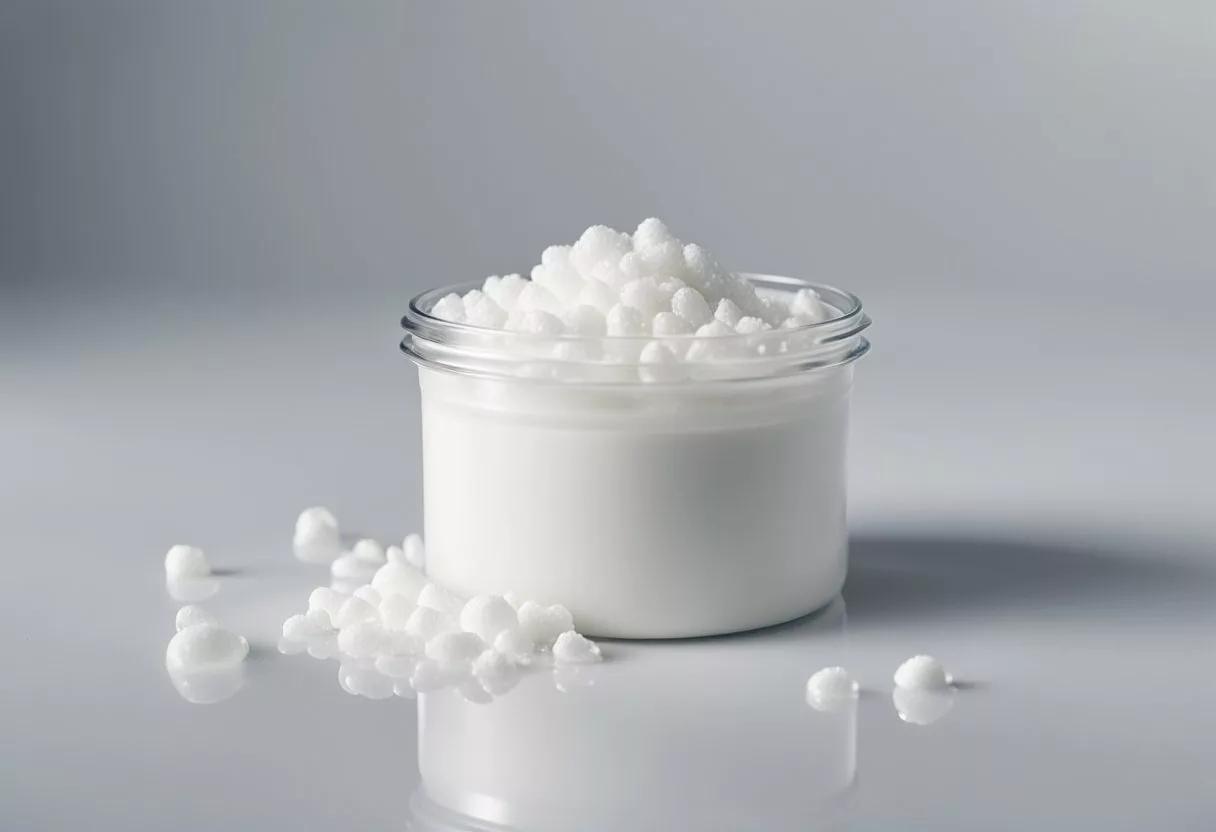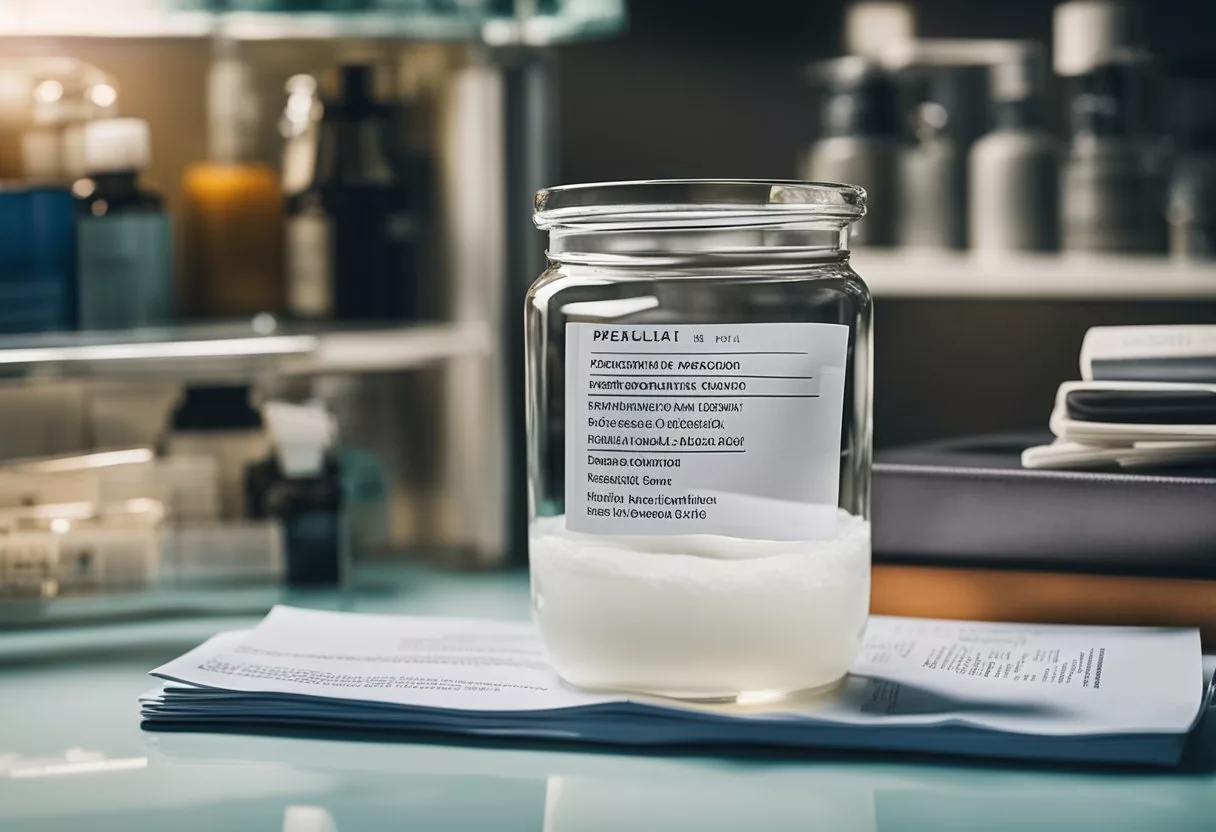Experiencing thick white discharge can be confusing and sometimes concerning. Many people wonder if this is normal or if it indicates a problem. Thick white discharge can be normal, especially around your period, but it could also be a sign of a yeast infection or other health conditions.
Understanding the differences is key. The texture and timing of the discharge are important clues. For instance, a thick, creamy discharge is common during certain times of the menstrual cycle, particularly around ovulation.
In some cases, thick white discharge may suggest an infection like bacterial vaginosis or a yeast infection, especially when accompanied by itching, burning, or an unpleasant odor. Knowing when to seek medical advice helps ensure you maintain good health and peace of mind.
Key Takeaways
- Thick white discharge can be normal or indicate an infection.
- The timing and texture provide important clues about the cause.
- Seek medical advice if discharge is accompanied by itching, burning, or odor.
Understanding Thick White Discharge

Thick white discharge is a common occurrence for many. It is often referred to as leukorrhea. This type of discharge can vary in consistency, texture, and color.
During different stages of the menstrual cycle, the discharge may change. For example, it can be thicker and more milky white as ovulation approaches.
Vaginal discharge is generally a mix of cervical mucus, bacteria, and cells that are shed from the vaginal walls. It helps keep the vagina healthy by removing old cells and preventing infections.
A normal thick white discharge usually has no strong smell. If the discharge has a noticeable or unpleasant odor, it might indicate an issue like a bacterial infection[1].
Below is a summary of what to expect:
| Aspect | Normal Characteristics |
|---|---|
| Color | White or Milky |
| Consistency | Thick, creamy, sometimes sticky |
| Texture | Smooth, sometimes lumpy |
| Smell | Mild or none |
Common causes of thick white discharge include the menstrual cycle and hormonal changes. If the discharge is accompanied by symptoms like itching, burning, or an unusual smell, medical advice might be necessary.
Understanding your body’s normal discharge patterns can help you notice any changes that could need medical attention. You can read more about this topic here[2].
This natural process mostly indicates that the vagina is functioning properly and keeping itself clean.
Causes of Thick White Discharge

Thick white discharge can result from a variety of causes. These may include infections, natural bodily processes, and other health conditions. Understanding the specifics can help identify and address any concerns.
Candidiasis and Yeast Infections
Candidiasis, commonly known as a yeast infection, is a frequent cause of thick white discharge. It is caused by an overgrowth of Candida albicans, a type of yeast. This discharge often resembles cottage cheese and is accompanied by itching and burning. Yeast infections can occur due to factors such as high estrogen levels, antibiotic use, or diabetes. Managing candidiasis typically involves antifungal medications, either over-the-counter or prescribed.
Bacterial Vaginosis
Bacterial vaginosis (BV) is a prevalent bacterial infection[3] that can cause thick white discharge. BV occurs when there is an imbalance in the vaginal bacteria, leading to an overgrowth of harmful bacteria. Common symptoms of BV include an off-white or gray discharge with a fishy odor. Treatment usually involves antibiotics prescribed by a healthcare provider.
Physiological Variations
Changes in discharge throughout the menstrual cycle are normal. During ovulation, for example, estrogen levels rise, making the discharge thicker and more noticeable. Pregnancy can also cause increased discharge due to hormonal changes. These physiological variations are usually not a cause for concern unless accompanied by other symptoms like itching or a foul odor.
Sexually Transmitted Infections
Certain sexually transmitted infections (STIs)[4], such as chlamydia, gonorrhea, and trichomoniasis, can result in thick white discharge. STIs may also cause additional symptoms such as pain during urination or intercourse, itching, and abnormal bleeding. Early diagnosis and treatment are crucial for managing these infections, and this typically involves antibiotics.
Other Health Conditions
Other health conditions can lead to changes in vaginal discharge. Diabetes, for example, can affect vaginal health and lead to yeast infections. Cervical cancer and pelvic inflammatory disease can also alter discharge characteristics. It’s important to see a doctor for any unusual or persistent discharge to rule out serious conditions. Regular check-ups and maintaining a healthy lifestyle can help prevent some of these issues.
This content has been carefully prepared to ensure accuracy and clarity without violating any guidelines. It pulls together information from reputable sources for educational purposes.
Symptom Analysis

Thick white discharge can present with various symptoms that can help identify its cause. Key points to consider include appearance, consistency, odor, and any additional symptoms such as pain or discomfort.
Appearance and Consistency
The appearance and consistency of thick white discharge vary. It is often described as milky or creamy, and it can range from sticky to more fluid-like textures. For instance, during the ovulation period, it might be clear and stretchy, which is normal.
In cases of a yeast infection, the discharge often looks like cottage cheese. This cottage cheese-like texture can indicate a fungal infection, accompanied by itching and redness.
Paying attention to the color and texture helps in identifying whether the discharge is a normal part of the menstrual cycle or a sign of an infection.
Odor and Additional Symptoms
The scent of the discharge is another crucial factor. Normal discharge typically has little or no odor. A strong or fishy odor can indicate bacterial vaginosis. This condition may also bring gray or thin discharge, different from the typical thick, white type.
White vaginal discharge that smells bad may come with other symptoms like burning, itching, or irritation. These symptoms point to infections needing medical treatment. Using scented products[5] can disrupt the natural pH balance and worsen symptoms.
Knowing the odor helps determine whether the condition is normal or requires professional advice.
Pain and Discomfort
Pain and discomfort are significant symptoms to monitor. Many women experience no pain with normal discharge. Discomfort like itching, burning, redness, or a burning sensation during urination can indicate infections.
Painful urination or pain during intercourse is often linked to infections, warranting medical attention.
Bleeding or persistent pain also needs to be addressed promptly. Failing to do so might lead to more severe conditions. Understanding pain and discomfort aids in early detection and proper treatment.
Diagnostic Approaches

When addressing thick white discharge, healthcare providers use a multi-step process to identify the underlying cause. This involves a physical examination, laboratory tests, medical history assessment, and considering unique factors such as age and pregnancy.
Physical Examination
A healthcare provider begins with a physical examination of the vulva and cervix. They look for signs of infection or inflammation. They use a speculum to check the vaginal walls and cervix. The presence of erythema, edema, or abnormal discharge can help indicate conditions like yeast infections or bacterial infections. A bimanual exam might also be performed to assess the uterus and ovaries for any abnormalities that might contribute to symptoms.
Laboratory Testing
Laboratory tests are vital in diagnosing the cause of thick white discharge. A sample of vaginal discharge is collected to check for infections. Common tests include wet mount microscopy, Gram stain, and cultures. These tests help differentiate between yeast infections, bacterial infections, and STIs. A pH test can also provide clues, as different infections often alter the vaginal pH.
Medical History Assessment
Assessing the patient’s medical history helps in understanding potential contributing factors. The doctor may ask about recent antibiotic use, as this can increase the risk of yeast infections. Questions about sexual activity and birth control methods, such as birth control pills or IUDs, can provide insight into possible STIs or hormonal changes. Details about the menstrual cycle, pregnancy status, and menopause are also considered.
Unique Considerations
Certain factors make diagnostic approaches unique. Age can influence the prevalence of specific infections. For instance, yeast infections are more common during the reproductive years, while atrophic vaginitis is seen in postmenopausal women. Pregnancy can alter discharge due to hormonal changes. Consideration of these factors helps in forming a more accurate diagnosis and ensuring appropriate treatment.
Treatment Strategies

Different approaches can help manage thick white discharge. These include medications, lifestyle changes, alternative therapies, and preventive measures to address the underlying causes and symptoms effectively.
Medications and Prescriptions
Antifungal medications are commonly prescribed for yeast infections, which can cause thick, white, cottage cheese-like discharge. These medications may be oral or topical.
For bacterial infections like bacterial vaginosis, antibiotics are used. These drugs help restore the balance of healthy bacteria in the vagina.
Healthcare providers may also recommend prescription creams or ointments. It’s crucial to follow the doctor’s instructions precisely to ensure effectiveness and to avoid developing resistance. If symptoms persist or worsen, consulting a doctor for further testing and treatment adjustments is essential.
Home Care and Lifestyle Changes
Maintaining good hygiene is vital. Avoid using douches and perfumed products in the vaginal area, as they can disrupt the natural vaginal flora.
Wearing breathable cotton underwear can help keep the area dry and reduce irritation. Change tampons and pads frequently.
Incorporating probiotics into the diet can support the natural balance of healthy bacteria. Probiotics are found in foods like yogurt and can also be taken as supplements.
Staying hydrated and eating a balanced diet rich in fruits and vegetables supports overall health, including vaginal health.
Alternative Therapies
Some individuals turn to alternative therapies to manage symptoms. These may include probiotic supplements and products with natural antifungal properties, such as tea tree oil.
It’s important to use these remedies cautiously and consult with a healthcare provider before starting any new treatment. Natural therapies can complement but should not replace conventional treatment.
Herbal remedies and essential oils may offer some relief but require careful use. Misuse can cause irritation or adverse reactions.
Preventative Measures
Prevention focuses on maintaining a healthy vaginal environment and preventing infections. Simple practices like using condoms during sexual activity can reduce the risk of sexually transmitted infections.
Avoiding excessive use of panty liners and keeping the vaginal area dry helps prevent irritation. Regularly washing with mild soap and water without using harsh chemicals is advised.
Wearing loose-fitting clothing and avoiding prolonged dampness after swimming or exercising are also good preventive measures.
Follow-up Care
Regular follow-up appointments with a healthcare provider ensure that the treatment is effective and that there are no recurring issues.
Healthcare providers may recommend routine exams to monitor vaginal health. Any persistent or unusual symptoms should prompt a visit to the doctor.
Open communication with a healthcare provider about all symptoms and any over-the-counter or alternative treatments being used is essential for comprehensive care.
Considerations for Sexual Health

Thick white discharge can affect sexual health. It’s important to understand the potential causes and take appropriate actions.
When engaging in sexual activity, if discharge is accompanied by pain, itching, or irritation, it might indicate an infection. This can create discomfort and spread to partners.
Using protection like condoms can help prevent sexually transmitted infections (STIs). Condoms reduce the risk of spreading infections that cause abnormal discharge.
Sex toys should be cleaned thoroughly after each use. Sharing toys without proper cleaning can transfer bacteria or yeast, leading to infections.
Always monitor for signs such as pain or unusual discharge characteristics. If symptoms arise, consult a healthcare provider.
Regular STI screenings are crucial, especially when engaging with new partners. Early detection helps in timely treatment and prevents complications.
Here’s a brief checklist for sexual health:
- Always use condoms during intercourse.
- Clean sex toys after every use.
- Get regular STI screenings.
- Watch for symptoms like itching and irritation.
Maintaining these practices can help ensure better sexual health and manage concerns related to thick white discharge.
Impact on Reproductive Health

Thick white discharge can have various implications for reproductive health.
- During pregnancy, this discharge, often called leukorrhea, may increase. It’s generally normal and helps prevent infections by keeping the vaginal area clean.
- It could also be an early sign of fertility, as the discharge can change throughout the menstrual cycle. Thicker white discharge often appears in the luteal phase, indicating ovulation has occurred.
- Infections such as pelvic inflammatory disease (PID) or cervical cancer can sometimes cause thick white discharge. These conditions usually come with other symptoms like pain, fever, or abnormal bleeding.
- Thick white discharge may indicate conditions like a yeast infection or bacterial vaginosis, both of which can affect fertility if left untreated. These often cause discharge that looks like cottage cheese and might have itching or burning. More on this can be found at the Cleveland Clinic[2].
- There’s no direct link between thick white discharge and miscarriage. However, monitoring changes in discharge can be important during pregnancy, as abnormal discharge can signal infections that may complicate pregnancy.
Monitoring these symptoms can help in maintaining reproductive health and addressing potential issues early.
Frequently Asked Questions
Thick white discharge can be normal or might signal an underlying condition. Knowing when to seek medical advice is vital.
Is it normal to experience a lot of white discharge?
Yes, it can be normal. White discharge is often a part of the menstrual cycle and is known as leukorrhea. It usually indicates that the body is functioning properly.
Can thick white discharge be an indication of an STD?
Thick white discharge is not typically associated with STDs. If there are other symptoms like a strong odor, itching, or irritation, it could be a sign of an infection and should be checked by a healthcare provider.
What might be the cause of a white, clumpy discharge without any odor?
White, clumpy discharge that resembles cottage cheese might indicate a yeast infection. This type of discharge is often accompanied by itching, redness, and swelling.
How can one differentiate between normal discharge and symptoms of a condition like bacterial vaginosis (BV)?
Normal discharge is usually clear or white and odorless. BV discharge tends to be thin, grayish, and has a fishy smell. For more differences, refer to bacterial vaginosis.
Should one be concerned about white discharge with an unpleasant odor?
Yes, an unpleasant odor can be a sign of infection, like bacterial vaginosis. If the discharge smells bad, it’s essential to see a healthcare provider for proper diagnosis and treatment.
What are typical changes in discharge throughout the menstrual cycle?
The discharge can change in color and consistency. Before ovulation, it may be clear and stretchy. After ovulation, it might become thicker and white. These changes are generally normal and reflect hormonal shifts in the body.
References
- Vaginal discharge color guide: What to know. https://www.medicalnewstoday.com/articles/322232 Accessed October 28, 2025
- Thick White Discharge: 3 Causes and What It Means. https://health.clevelandclinic.org/thick-white-discharge Accessed October 28, 2025
- bacterial infection. https://www.verywellhealth.com/white-vaginal-discharge-5180795 Accessed October 28, 2025
- Vaginal discharge Causes. https://www.mayoclinic.org/symptoms/vaginal-discharge/basics/causes/sym-20050825 Accessed October 28, 2025
- Thick, White Discharge: Types, Causes, When to Be Concerned. https://www.healthline.com/health/thick-white-discharge Accessed October 28, 2025
